- Track 1: shape01 (11:03)

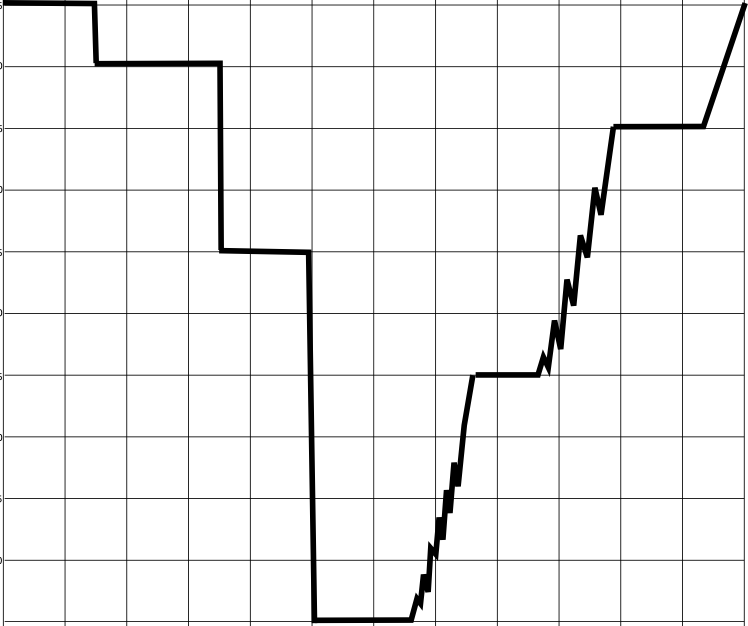

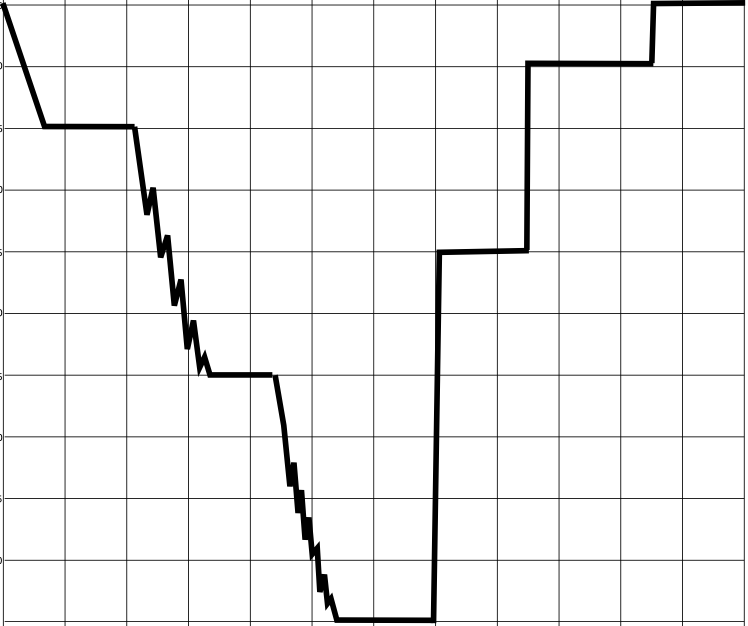
The composition process began with the drawing of a "shape,"
the first of the four shapes illustrated here (the "original".) The remaining shapes are
derived from the original shape. The second shape is the "inverse" of the
first (original, flipped upside down.) The third is the "retrograde" of the first
(original, flipped backwards.) The fourth and final shape is "retrograde of the inverse,"
also called the "cancrizan" (original, flipped backwards and upside-down.)
These shapes are used as "control signals" in the composition. Control
signals are simply numerical values that vary, sometimes slowly, sometimes rapidly,
over the course of the
composition. In shape01 the control signals are used to determine
the rate at which tones occur, the durations and amplitudes of the tones,
and the pitch of the tones.
Csound, according to computer code written by the composer, generates
these tones, sometimes hundreds of overlapping tones per second. (This form of
sound creation is called "granular synthesis.") The overlapping
tones combine to create the ultimate sound. Since the rate of tone creation,
the duration of each tone, the amplitude of each tone and the pitch of each tone are changing
according to one or another of the four control signals, they don't all
change together. Therefore the resulting sound is constantly evolving.
shape01 is characterized by long glissandi, which
are dictated by the slanting lines in the shapes. In this piece, and
most others from this period, dissonances often resolve into consonances.
- Track 2: shape02 (8:08)
While shape01 was constrained to use only
four shapes as control signals, shape02 uses additional shapes,
obtained by combining the original signals. The "original", "inverse",
"retrograde" and "cancrizan" signals look like this:
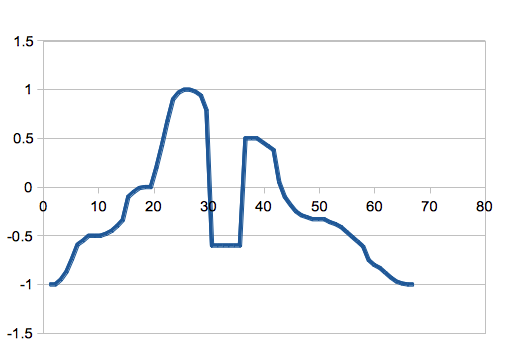
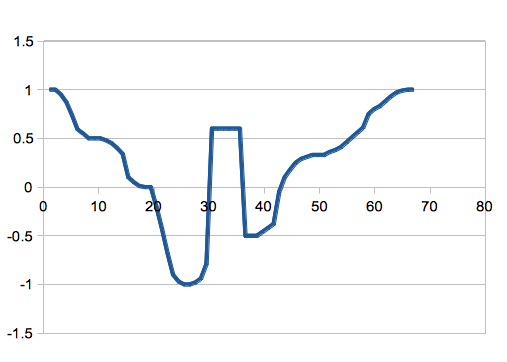
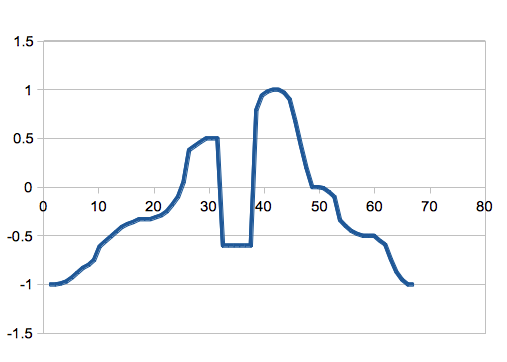
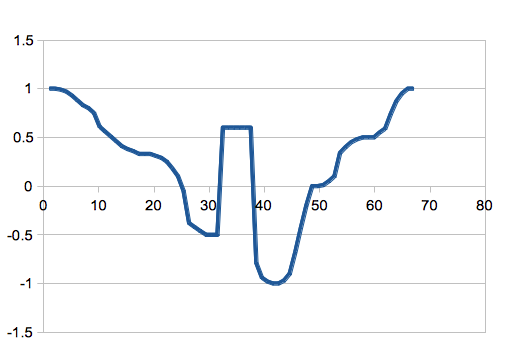
Some of the shapes obtained by combinations are "original+retrograde",
"inverse+cancrizan", "retrograde+original", and "cancrizan+inverse",
to name just a few:
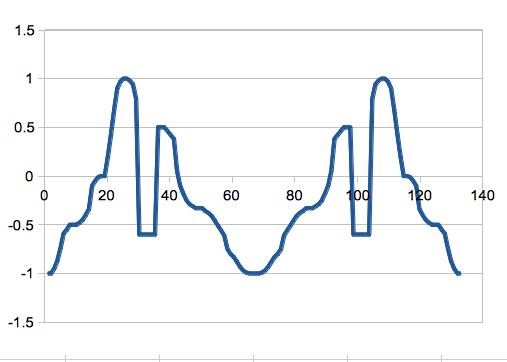
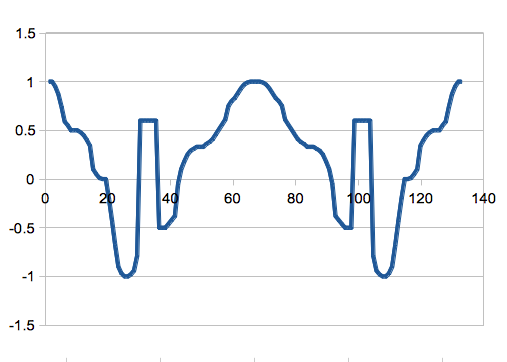

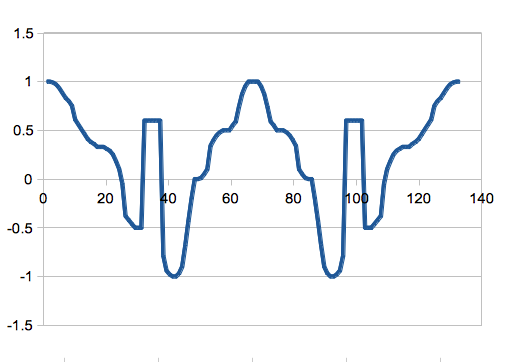
The use of more than just the four basic shapes made it easier to create
more variety.
shape02 contains much more "static" than shape01, and no
clear consonances. The emphasis is more on rhythm.
- Track 3: shape03 (6:00)
shape03, like shape02, uses the
four "standard" signals as well as signals derived from them. Here are
the "standard" signals (original, inverse, retrograde, cancrizan):
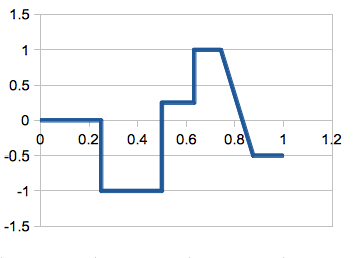
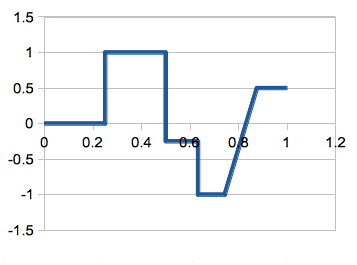

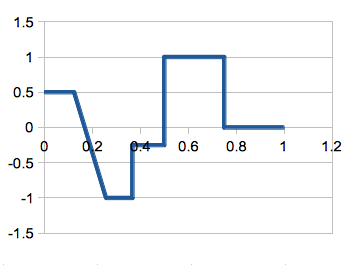
shape03 exploits a mixture of rhythmic events and unisons.
- Track 4: shape04 (8:22)
shape04 uses a variety of shapes to control
the musical elements (note density in time, pitch, duration, amplitude, etc.).
The piece has an arch-shape, starting with very slow low notes, building
to rapidly occurring high pitches, then moving back to the slow, low sounds
of the beginning. As with many other shapes, there is an interplay
between dissonance and consonance.
- Track 5: shape05 (6:52)
shape05 uses one of several of its shapes
to determine how closely each note's pitch comes to one of the tones
in a dominant-seventh chord. When the notes stray from the tones in
the dominant-seventh chord, dissonance results. As the pitches approach
the chord, the consonance emerges more and more clearly.
- Track 6: shape06 (7:07)
shape06 is built around a conventional chord sequence.
Each note played may include rapidly played ornaments (trills, mordants,
turns and more complex ornaments.) The shapes in this composition
determine how closely the pitch of notes approaches the pitches of the
notes in the chord sequence. Other shapes determine the nature of the
ornaments (how many notes, how rapidly played, etc.)
- Track 7: shape07 (6:48)
shape07 combines musical ideas used in shape04
and shape06: low notes to high notes to low notes (two cycles); proximity/distance of
pitches to consonant chords, and the generation of ornaments.
- Track 8: shape08 (6:34)
shape08 further exploits the interplay of
dissonance and consonance used in previous pieces. The sound source
is created by the Csound opcode "pluck", which produces a wide range
of pluck-like sounds.
- Track 9: shape09 (7:03)
shape09 again exploits the interplay of
dissonance and consonance.
- Track 10: shape10 (6:40)
shape10 again exploits the interplay of
dissonance and consonance. This piece uses ornaments similarly to some
previous pieces. The control signals, again produced by various
shapes, control the proximity/distance to consonance, the speed and
complexity of
the ornaments, and many other factors in the piece.
- Track 1: Harmonies (6:30)
This piece consists of the mixing of several "soundbites",
that is, several short segments of sound. The soundbites are of durations
varying from about 3-tenths of a second to 20 seconds. Each
of the soundbites consists of a superposition
of several tones (generated by Csound.). The characteristics of each tone (frequency, amplitude, etc.)
were determined at random by use of a spreadsheet's "RANDOM" function.
The piece begins with the longer soundbites, progresses to the shortest
soundbites, and then ends with longer soundbites.
- Track 2: Homage To Cage (8:43)
This piece was composed for the Bohlen-Pierce
Symposium held in Boston, March 2010. "Bohlen-Pierce" is the name of
a microtonal scale system of special interest to some music theorists
and composers. Homage To Cage uses the Bohlen-Pierce scale throughout.
The structure of the piece was suggested by (but is not identical to) techniques developed by
John Cage in the period when Cage was first exploring the use of random
methods for composition; in particular, Cage's method of composing Music Of Changes.
First, a "source sound file" was created. This sound file includes a
range of sounds produced by Lou Cohen's Csound improvisation project.
The file simply contains one type of synthesized sound after another with no particular
musical intention.
Next, a spreadsheet was created, using the RANDOM function, to determine
(randomly) the number of sections in the composition, the length of
each section, the number of sound-events, the length of each sound-event,
and the portion of the source sound file from which to select each sound.
Finally, the sounds selected this way were manually cut-and-pasted
from the source sound file into the final
composition.
The methods developed for this piece became the basis for all the Symphonies.
- Track 3: Concerto (7:34)
This piece explores the interplay of "soloist" and
"orchestra" which characterizes most concertos. Because the solo instrument
(such as a violin or piano) is generally much quieter than the accompanying
orchestra, the composer must carefully arrange things so that the
soloist's sound is not drowned out. In this piece the "solo" instrument
is a combination of toy piano, clavichord and marimba samples. The "orchestra"
sounds include horn, strings, baritone saxophone, bass clarinet, and tenor recorder.
- Track 4: Circles (12:25)
Circles is one of Cohen's earliest electronic
pieces, written in 2004. Various circles are described mathematically
by equations in a multi-dimensional space. The dimensions represent
musical elements, such as duration, amplitude, amplitude-envelope, pitch,
number of simultaneous notes, and
other aspects of each note.
As the path of a circle is traversed over time, the circle is traversed
through space. Therefore these characteristics vary, hence the sound
of the music varies. The path, in time, of each circle through space
results in an audio track of sound. The equations have been set up in such
a way that the circles travel through the sound-space on different
paths, but are designed to come in contact with each other somewhere
(and at some time) during the composition. The effect is that the
sounds of the tracks are identical when the circles are in contact,
but then diverge as the paths of the circles diverge. The sounds
then converge again as the paths of the circles once again
approach the contact points.
- Track 5: Symphony 1 (10:07)
All the Symphonies use the same basic technique, which
was first used in Homage To Cage: one or several "source sound"
files was created, and then short sound sections were cut from the
source files and pasted into the final composition. While the cut/paste
process in Homage To Cage was performed manually, it was performed
automatically in the Symphonies, by appropriate programming of Csound.
The source audio file for Symphony 1 uses synthesized sounds
produced by Lou Cohen's mouse/keyboard
improvisational Csound project. The piece has 24 sections; the length
of each section was chosen by a random number generator. Also determined at
random are the number of sound events (each taken from the source file)
in each section, the durations
of the events, the section of the source file from which the
sounds are selected, and within each source section, the starting position
of each selected sound event. The sound events are generally long
enough so that hints of the original improvisation can be heard.
- Track 6: Symphony 2 (20:00)
The source file for this piece was created by the
composer improvising with his wiimote/laptop Csound project. A 56 minute
source file was produced. The Symphony has 13 sections. The first section
of the Symphony uses sounds from a single section of the source file.
The second section uses sounds from two different sections of the source
file. Each subsequent section of the symphony uses sounds from more
distinct source file sections until section 7 of the Symphony. From section 8
on, the number of source file sections used is reduced until the
thirteenth and final section, which once again uses only one section
from the source file. As with Symphony 1,
the duration of each section, the exact location and duration of each source
sound event, and exact positioning of each "paste" operation was left
to chance (by using a spreadsheet program's random number generator.)
- Track 1: Symphony 3 (12:50)
The source material for Symphony 3 is taken
from improvisations with Lou Cohen's wiimote/laptop project. The Symphony's
structure is suggested by classical forms often found in traditional
symphonies. There are 4 sections to the piece, played without pause:
Introduction; Theme and Variations; Scherzo; Finale.
- Track 2: Symphony 4 (12:07)
The source material for Symphony 4 consists of
"Factory Sounds" - sounds built-in to Apple's Digital Audio Workstation
Logic. The selected sounds are primarily percussion and hip-hop
sounds, activated by MIDI. The composer improvised at a MIDI keyboard
to create the final source audio file. The piece consists of 27 sections,
each somewhat longer than 26 seconds in length. The 27 sections are divided into 3 subsections
with a general A-B-A structure.
Each of the subsections is in turn divided into 3 sub-subsections, each
of which displays an a-b-a substructure.
- Track 3: Symphony 5 (13:32)
Source audio material for Symphony 5 consists
of samples of acoustic instruments: flute, oboe, bass clarinet, contrabassoon,
horn, trumpet, tuba, viola, violin, cello, double bass and piano.
These samples were activated by the composer improvising at a MIDI
keyboard. The piece consists of 45 sections each 17.5 seconds long, and a
final 46th section of 10 seconds. Each of the sections employs a
different combination of the source instrument sounds. The combinations
were determined with the help of Orthogonal Arrays (OAs.) For more
about OAs, see Method of composition.
- Track 4: Symphony 6 (for Noah Creshevsky) (9:33)
The source material for Symphony 6 consists
of samples of acoustic instruments: flute, violin, viola, cello, double bass.
The samples were activated by the composer improvising at a MIDI
keyboard, thereby creating the source audio file.
The piece consists of 36 sections, each 16.67 seconds in length. Various
combinations of source sounds were selected from each section by the use
of Orthogonal Arrays.
- Track 5: Symphony 7 (7:22)
The source material for Symphony 7 is derived
from synthesized sounds devised by the composer (using Csound.) These
sounds were placed in a soft-sampler so that they could be activated
by the composer's improvisations at a MIDI keyboard. The piece consists
of 9 pairs of sections, each pair 48 seconds long.
- Track 6: Symphony 8 (10:33)
The source material for Symphony 8 is derived
from direct recordings of the composer's Steinway piano, played normally
and also played by plucking and scraping the piano strings. Among other
sounds, very long
piano tones were recorded. These were sometimes played back with the
initial attack of the note omitted, so that the sounds resemble bowed,
rather than hammered or plucked strings. The composer improvised
directly at the piano keyboard to create portions of the source audio
file. The various types of improvisation and other piano sounds were
divided into categories which were selected from different sections by
means of an Orthogonal Array. There are 18 sections of 20 seconds each.
There are also generally two layers of sound, one consisting of the
"bowed" sounds; the other of all other recorded sounds.
- Track 7: Symphony 9 (6:40)
The source material for Symphony 9 comes from
a range of synthesized sounds readily available in Apple Computer's
Digital Audio Workstation Logic and also variations on those
readily available sounds. There are 13 sections of 30 seconds each.
Random processes were used to determine which source sounds were
used in each section.















